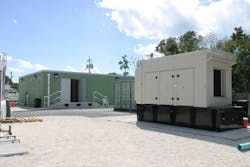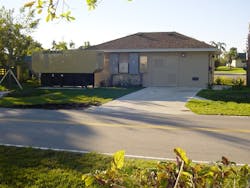Hurricane Preparedness
Hurricanes create serious problems for public works officials—mass evacuations, high winds, flooding, the loss of utilities and damage to public facilities, to name a few. All are bad, but equally troubling is the potential for disease outbreak.
In 2017, an indeterminate amount of wastewater, probably in the millions of gallons, escaped into communities across Florida after Hurricane Irma. This created the potential for the spread of diseases and the contamination of the public’s drinking water supply.
The sewage entered the environment because municipal sewer pumping stations lost electrical power during the storm and shut down—some for weeks. Sewage backups allowed untreated wastewater to pollute the storm waters that flooded many communities. Some people were literally walking in sewage-contaminated water. The untreated wastewater also found its way into groundwater supplies and, in some cases, was in contact with potable water lines, making drinking water unsafe.
Fears of cholera, hepatitis A and other infectious diseases were real, making an already difficult disaster situation far worse. However, not every Florida city had this concern.
The Solution
A number of towns in the path of Hurricane Irma have vacuum sewers by Airvac. Many vacuum sewer systems, such as those in Sarasota County in Southwest Florida and Marathon in the Florida Keys, are equipped with fixed backup generators. The generators kick in whenever electrical power is lost, which allows the sewers in the area to function normally. There are no sewer backups, there is no water contamination, and utility workers are free to deal with other storm-related issues.
The Airvac sewers also benefit the public works departments of these communities by keeping their workers out of harm’s way. Many towns with gravity sewers scrambled to place portable generators at lift stations before and during the storms. This was dangerous duty for employees who were sometimes forced to work with electrical equipment in extremely high winds and driving rains.
In addition to the safety provided by vacuum sewers, they prevented massive infiltration of storm water into the wastewater treatment facilities, thus saving money and treatment capacity.
Hurricanes are common along the eastern seaboard and the Gulf Coast of the United States. Statistics from the National Oceanographic and Atmospheric Administration indicate a Category 1 or stronger storm has hit the U.S. mainland 293 times since 1851—an average of 1.7 per year—yet only a small percentage of seaside communities currently have vacuum sewer technology. This is slowly changing as cities rethink the practicality and value of vacuum sewers in the face of devastating hurricanes.
Coastal communities can expect major storms to occasionally bring damage and destruction. However, they can mitigate the situation beforehand by installing modern vacuum sewer technology.
Hurricane Alley
South Florida is the most likely place in the continental United States to be hit by a hurricane, according to Sperling’s Best Places. Based on tropical storm data over the past 100 years, these are the mostly likely hurricane targets in North America:
- Southeast Florida (Miami, Fort Lauderdale, West Palm Beach)
- Key West and the Florida Keys
- Southwest Florida (Fort Myers, Naples)
- West Florida (Tampa, St. Petersburg, Sarasota, Clearwater)
- Outer Banks, North Carolina (Cape Hatteras)
- Central Texas Gulf Coast (Galveston)
- Central Florida Atlantic Coast (Melbourne, Cocoa Beach)
- Florida Panhandle (Pensacola, Panama City)
- Central Gulf Coast (New Orleans; Biloxi, Miss.; Mobile, Ala.)
- South Texas Gulf Coast (Corpus Christi, Brownsville)
Only three Category 5 hurricanes have made landfall in the U.S.: Andrew in 1992, Camille in 1969 and an unnamed storm in 1935. A Category 5 hurricane has sustained winds of 155 mph; a Category 1 hurricane has sustained winds of 74 to 95 mph.

